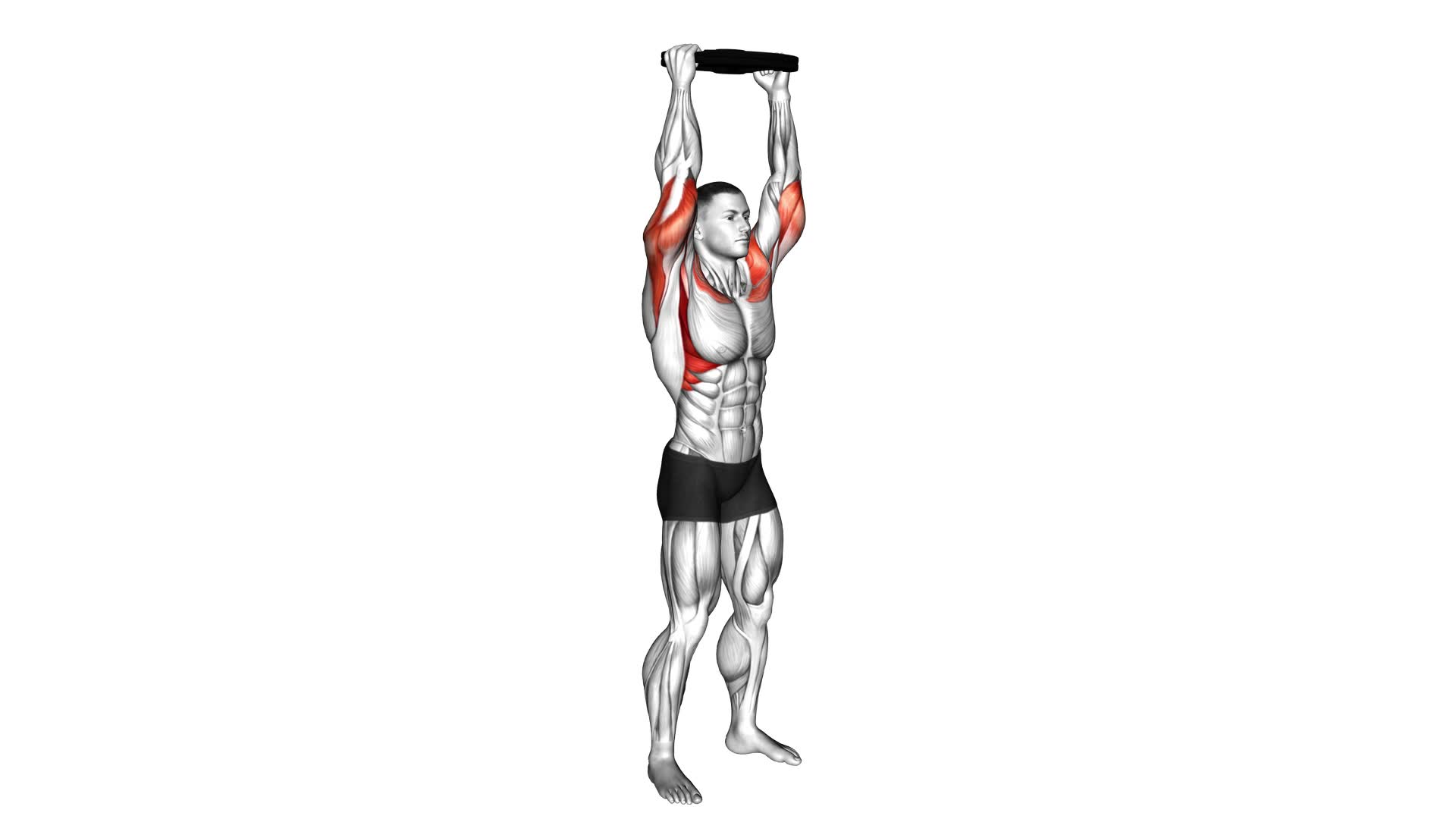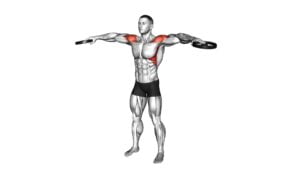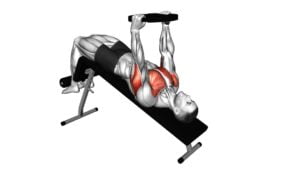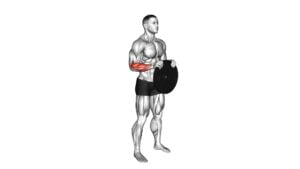Weighted Plate Standing Overhead Press – Video Exercise Guide & Tips

Are you looking for a challenging exercise to strengthen your shoulders and upper body? Look no further than the weighted plate standing overhead press!
Watch This Exercise Video
This guide will show you the proper form and technique for this exercise, along with common mistakes to avoid.
With variations and modifications for all fitness levels, you can easily incorporate this exercise into your workout routine.
Get ready to feel the burn and see results with the weighted plate standing overhead press!
Key Takeaways
- The weighted plate standing overhead press targets shoulders, triceps, and upper back muscles.
- Proper form and technique include gripping the plate with palms facing down, standing with feet shoulder-width apart, and fully extending the arms overhead without locking elbows.
- Common mistakes to avoid include using too much weight, arching the back, locking out the elbows, and using momentum instead of proper form.
- Variations and modifications for all fitness levels include single-arm overhead press, kneeling overhead press, seated overhead press, and reduced weight options.
Benefits of the Weighted Plate Standing Overhead Press
The Weighted Plate Standing Overhead Press offers several benefits for strengthening your upper body. This exercise primarily targets your shoulders, triceps, and upper back muscles. By pressing the weighted plate overhead, you activate your deltoids, particularly the anterior and lateral heads. Additionally, your triceps are engaged as they assist in extending your arms. The upper back muscles, including the rhomboids and trapezius, also contribute to stabilizing and supporting the movement.
To progress and increase the weight for the overhead press, start with a weight that challenges you but allows you to maintain proper form. As you become comfortable with the exercise, gradually increase the weight in small increments. This progressive overload helps to stimulate muscle growth and strength gains. It's crucial to maintain control throughout the movement and avoid using momentum to lift the weight.
Incorporating the Weighted Plate Standing Overhead Press into your upper body workout routine can help you develop stronger shoulders, triceps, and upper back muscles. Remember to focus on proper form and gradually increase the weight to continue challenging your muscles.
Proper Form and Technique for the Exercise
Maintain a stable and upright position throughout the Weighted Plate Standing Overhead Press. This exercise requires proper form and technique to maximize its benefits and minimize the risk of injury. Here are some key points to remember:
- Grip the weighted plate with both hands, keeping your palms facing down and your fingers spread wide for stability.
- Stand with your feet shoulder-width apart and engage your core muscles to maintain a strong and stable base.
- Lift the weighted plate to shoulder height, bending your elbows and keeping them slightly in front of your body.
- Press the plate overhead by extending your arms fully, but without locking your elbows.
- Keep your head aligned with your spine and your gaze forward throughout the movement.
- Lower the plate back down to shoulder height in a controlled manner, maintaining tension in your muscles.
- Repeat for the desired number of repetitions.
Proper form and technique are crucial to getting the most out of the Weighted Plate Standing Overhead Press. By maintaining a stable and upright position, you'll engage your shoulder, back, and core muscles effectively. Remember to start with a weight that allows you to maintain proper form and gradually increase the weight as you become more comfortable and stronger.
Common Mistakes to Avoid
To avoid common mistakes while performing the Weighted Plate Standing Overhead Press, you should ensure proper form and technique. One common mistake is using too much weight. It's important to start with a weight that you can comfortably lift and gradually increase as you become stronger. Using too much weight can lead to poor form, which increases the risk of injury.
Another mistake to avoid is arching your back. Keep your core engaged and your spine straight throughout the movement. Arching your back puts unnecessary strain on your lower back and can lead to discomfort or injury.
It's also important to avoid locking out your elbows at the top of the movement. This places excessive stress on the joints and can lead to strain or injury. Instead, focus on fully extending your arms without hyperextending.
Lastly, avoid using momentum to lift the weight. This takes away from the effectiveness of the exercise and can lead to poor form. Remember to use controlled, smooth movements throughout the entire exercise.
Variations and Modifications for All Fitness Levels
Continue progressing your Weighted Plate Standing Overhead Press by exploring variations and modifications suitable for all fitness levels.
- Variations:
- Single-Arm Overhead Press: Instead of using both arms, perform the exercise with one arm at a time. This can help improve stability and target each side of your upper body independently.
- Kneeling Overhead Press: Kneel on the ground with one knee while performing the exercise. This variation increases the core engagement and stability required for the movement.
- Modifications:
- Reduced Weight: If you're a beginner or have limited upper body strength, start with a lighter weight plate or even a dumbbell. Gradually increase the weight as you get stronger.
- Seated Overhead Press: Sit on a bench or chair while performing the exercise. This modification provides additional support for your lower back and can be beneficial for those with balance or mobility issues.
Remember to choose the variation or modification that suits your current fitness level and goals. Always prioritize proper form and technique to maximize the effectiveness and safety of your workouts.
Tips for Incorporating the Weighted Plate Standing Overhead Press Into Your Workout Routine
To effectively incorporate the Weighted Plate Standing Overhead Press into your workout routine, focus on proper form and gradually increase the weight as you progress.
This exercise is a great way to strengthen and tone your shoulders while also engaging your core and upper body muscles. Here are some tips for incorporating this exercise into your routine:
- Start with a weight that challenges you but still allows you to maintain proper form. It's important to use a weight that you can handle without straining or compromising your technique.
- Begin by standing with your feet shoulder-width apart and the weighted plate held at chest level with both hands. Keep your core engaged and your back straight throughout the exercise.
- As you press the plate overhead, make sure to fully extend your arms without locking your elbows. Maintain control and stability throughout the movement.
- Lower the plate back down to chest level in a slow and controlled manner. This eccentric phase of the exercise is just as important as the concentric phase.
- Gradually increase the weight as you become stronger and more comfortable with the exercise. This will help you continue to challenge your muscles and make progress.
Incorporating weightlifting exercises like the Weighted Plate Standing Overhead Press into your routine can help improve strength and muscle definition in your shoulders. By following these tips and focusing on proper form, you can make the most out of this shoulder exercise technique.
Frequently Asked Questions
How Much Weight Should I Use for the Weighted Plate Standing Overhead Press?
To determine how much weight to use for the weighted plate standing overhead press, focus on your current strength and fitness level. Start with a weight that challenges you, but allows you to maintain proper form and technique. Gradually increase the weight as you progress, ensuring that you can still perform the exercise correctly.
Can I Perform the Weighted Plate Standing Overhead Press With a Barbell Instead of a Weighted Plate?
Yes, you can perform the weighted plate standing overhead press with a barbell instead of a weighted plate. While the exercise is typically done with a weighted plate, using a barbell as a substitution can offer additional benefits.
The barbell allows for a greater range of motion and can help to increase overall strength and muscle activation. Just make sure to use proper form and start with a weight that challenges you but is still manageable.
Are There Any Specific Warm-Up Exercises I Should Do Before Performing the Weighted Plate Standing Overhead Press?
Before performing the weighted plate standing overhead press, it's important to do some warm-up exercises. This will help prepare your muscles and joints for the movement. A few good warm-up exercises include shoulder circles, arm swings, and push-ups.
These exercises will increase blood flow, improve flexibility, and reduce the risk of injury. By warming up properly, you'll be able to get the most out of your weighted plate standing overhead press and maximize the benefits for your upper body strength.
How Often Should I Include the Weighted Plate Standing Overhead Press in My Workout Routine?
To determine how often you should include the weighted plate standing overhead press in your workout routine, consider your goals and fitness level.
As a general guideline, aim to include this exercise 2-3 times per week, allowing for adequate rest and recovery between sessions.
Start with a weight that challenges you but allows for proper form and gradually increase as you become stronger.
Remember to consult with a fitness professional for personalized advice.
Can the Weighted Plate Standing Overhead Press Help Improve My Posture and Core Strength?
The weighted plate standing overhead press is a great exercise to improve your posture and core strength. By engaging your core and stabilizing your spine, this exercise can help strengthen the muscles that support good posture.
Additionally, the overhead press targets your shoulders, arms, and upper back, which can lead to improved flexibility and overall upper body strength.
Incorporating this exercise into your routine will provide numerous benefits for your posture and core strength.
Conclusion
Incorporating the Weighted Plate Standing Overhead Press into your workout routine can provide numerous benefits, including improved upper body strength and stability.
By following proper form and technique, you can maximize the effectiveness of this exercise and avoid common mistakes.
Additionally, there are variations and modifications available for all fitness levels, allowing everyone to reap the rewards.
So, grab a weighted plate and start incorporating this exercise into your routine for a stronger and more toned upper body.

Author
Years ago, the spark of my life’s passion ignited in my mind the moment I stepped into the local gym for the first time. The inaugural bead of perspiration, the initial endeavor, the very first surge of endorphins, and a sense of pride that washed over me post-workout marked the beginning of my deep-seated interest in strength sports, fitness, and sports nutrition. This very curiosity blossomed rapidly into a profound fascination, propelling me to earn a Master’s degree in Physical Education from the Academy of Physical Education in Krakow, followed by a Sports Manager diploma from the Jagiellonian University. My journey of growth led me to gain more specialized qualifications, such as being a certified personal trainer with a focus on sports dietetics, a lifeguard, and an instructor for wellness and corrective gymnastics. Theoretical knowledge paired seamlessly with practical experience, reinforcing my belief that the transformation of individuals under my guidance was also a reflection of my personal growth. This belief holds true even today. Each day, I strive to push the boundaries and explore new realms. These realms gently elevate me to greater heights. The unique combination of passion for my field and the continuous quest for growth fuels my drive to break new ground.







